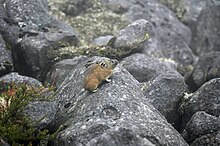Daisetsuzan National Park
|
Daisetsuzan National Park
|
||
|
View in summer from Mount Asahidake, Daisetsuzan National Park, August 2005 |
||
| location | Hokkaidō , Japan | |
| surface | 2,267.64 km² | |
| WDPA ID | 726 | |
| Geographical location | 43 ° 40 ' N , 142 ° 51' E | |
|
|
||
| Setup date | 4th December 1934 | |
| administration | Ministry of the Environment | |
| particularities | largest national park in Japan | |
The Daisetsuzan National Park ( Japanese 大雪山 国立 公園 , Daisetsuzan Kokuritsu Kōen, also Taisetsuzan ) is the largest Japanese national park with 2267.64 km² and is located on the island of Hokkaidō . The park was declared a national park on December 4, 1934 . The Daisetsu-zan itself is also one since 1977 natural landmark .
Mountain landscape
Daisetsuzan translates as “Great Snowy Mountains”, a good description of these peaks, 5 of which are over 2000 m and which form one of the most rugged areas in Japan.
They consist of three volcanic groups made up of layered volcanoes piled on top of one another . When a vent becomes active, it builds a peak and then becomes inactive until a new vent is created and forms a new peak.
The groups are:
- Daisetsuzan volcano group in the northern part of the park. Hokkaido's highest mountain, the Asahidake, belongs to her.
- Tokachi volcano group in the southwest of the park between the Yūbari and Hidaka mountains . This includes Mount Tokachi .
- Shikaribetsu volcanic group in the east of the park. Mount Ishikari belongs to it .
These volcanic groups are located around a central highland which is dominated by Mount Tomuraushi .
Wildlife

The park is known for its wildlife, which includes brown bears . Other notable species are the Hokkaido sika deer , the black woodpecker , the giant fish owl, and the Japanese pika . The butterfly species Parnassius eversmanni and Boloria freija occur in Japan only in this national park.
tourism
The park is attractive to visitors because of its alpine meadows and its diverse hiking opportunities. The park is also home to the Asahidake Onsen, Sōunkyō Onsen, and Tenninkyō Onsen hot springs .
Web links
- Daisetsuzan National Park - Japanese
- World Database on Protected Areas - Daisetsuzan National Park (English)
- Daisetsuzan National Park - English
Individual evidence
- ↑ Explanations of the animal world on the English-language homepage ( Memento from February 1, 2013 in the Internet Archive )


